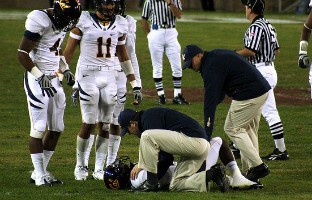Would Jesus love football?
The only good thing about the end of summer is that it's the beginning of the college football season. Once more college football is delivering thrills and surprises, with the rankings changing dramatically on a weekly basis, teams appearing out of nowhere to vie for the no. 1 ranking, and underdogs ceremoniously (college football is nothing if not ceremonious) knocking off highly favored teams. I love just about everything about the game, from the on-field heroics to the off-field pageantry.
But I make the qualification: just about everything about the game. I don't love everything. There's plenty to be cynical about when ostensibly amateur players get recruited as if they were professionals. Even a straight arrow like Ohio State coach Jim Tressel turns out to have run a fairly smarmy program. Yet it's not primarily the financially shady elements that make me ambivalent about my favorite sport. It's the sometimes dangerous levels of violence.
Read our latest issue or browse back issues.
I played football in high school, the eight-man version practiced in rural areas of states such as Oklahoma, where I grew up. I was an offensive lineman, and one day in practice our coach decided we needed to improve our goal-line play. To challenge the first-string players, he bunched 15 reserves across from us on the one-yard line. I snapped the ball to the quarterback, delivered my block, then straightened up on my knees. It was then that a defender (my cousin, as it happened) pivoted and launched himself at the ball carrier. His heel came up under my faceguard and smashed my nose. Subsequent surgery removed about half of the cartilage from my broken, clogged snout. The flat nose that I have sported ever since is not my natural nose but a product of football.
Current concerns about football concentrate on the prevalence of head injuries, especially the concussions and subconcussions that players routinely sustain. Medical science has found that "getting your bell rung" is more serious than once was thought. Long-lasting and sometimes severe brain injuries are the result of all that bell-ringing.
The concern about football violence is not new. A campaign to ban college football arose after 18 players died on the field in 1905. That famously rugged outdoorsman, President Teddy Roosevelt, convened panels to reform the sport. The next year the forward pass was introduced, transforming the game from what writer Ben McGrath called "militarized or corporatized rugby" to a kind of "contact ballet."
Further rule changes have tried to lessen the physical dangers to players. (It may not be long before linemen squat like sumo wrestlers rather than stand in three-point stances.) Equipment changes, such as the introduction of faceguards to helmets, have also helped reduce injuries. But no rule or equipment changes will eliminate all the violence from a sport that is based on knocking people down. I will have to live with ambivalence about the game.
My fellow followers of the Prince of Peace who love the bucolic game of baseball can rest easier than football fans. Baseball players get hurt, but violence is not a key component of their game. In football, several players are banging heads and risking at least subconcussions on every play.
Would Jesus have played or loved football? I am honestly not sure. But I am sure that true fans do not watch the game primarily to see spectacular hits or the mangling of bodies. What's exciting is the long pass, the almost impossible fingertip catch, the stealthy interception. Consider especially the long run or kickoff return, when the runner's ability to dodge tackles provides the frisson. At such moments it's clear that what fans really love is not the collision but the avoidance of a collision. As McGrath puts it, "Averted danger is the essence of football." I'll keep watching football not because of the game's violence, but because of its instances of (barely) avoided violence. That's what gives the game its beauty and its thrills.






